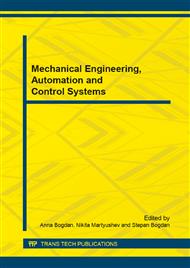[1]
V.M. Polyanski, Role of hydrogen embrittlement in the corrosion cracking of aluminum alloys, Sov. Mater. Sci., 21 (1985) 301-309.
Google Scholar
[2]
N.J. H. Holroyd, A.K. Vasudevan, L. Christodolou, Aluminum Alloys, ed. A.K. Vasudevan and R.D. Doherty, London: Academic Press, (1989).
Google Scholar
[3]
C. Larignon, J. Alexis, E. Andrieu et al. The contribution of hydrogen to the corrosion of 2024 aluminium alloy exposed to thermal and environmental cycling in chloride media, Corr. Sci., 69 (2013) 211-220.
DOI: 10.1016/j.corsci.2012.12.005
Google Scholar
[4]
E. Lunarska, O. Chernyaeva, Effect of precipitates on hydrogen transport and hydrogen embrittlement of aluminum alloys, Mater. Sci., 40 (2004) 399-407.
DOI: 10.1007/s11003-005-0049-2
Google Scholar
[5]
M.B. Kannan, V.S. Raja, Hydrogen embrittlement susceptibility of over aged 7010 Al-alloy, J. Mater. Sci., 41(2006) 5495-5499.
DOI: 10.1007/s10853-006-0287-1
Google Scholar
[6]
S.J. Kim, M.S. Han, S.K. Jang, Electrochemical characteristics of Al-Mg alloy in seawater for leisure ship: Stress corrosion cracking and hydrogen embrittlement, Kor. J. Chem. Eng., 26 (2004) 250-257.
DOI: 10.1007/s11814-009-0042-9
Google Scholar
[7]
S. Kumar, T. Namboodhiri, Precipitation hardening and hydrogen embrittlement of aluminum alloy AA7020, Bull. Mater. Sci., 34 (2011) 311-321.
DOI: 10.1007/s12034-011-0066-8
Google Scholar
[8]
H.M. Nykyforchyn, O.P. Ostash, O.T. Tsyrul'nyk, I.M. Andreiko, Yu.V. Holovatyuk, Electrochemical evaluation of the in-service degradation of an aircraft aluminum alloy, Mater. Sci., 44 (2008) 254-259.
DOI: 10.1007/s11003-008-9067-1
Google Scholar
[9]
S.A. Barannikova, Dispersion of the plastic strain localization waves, Tech. Phys. Lett. 30 (2004) 338-340.
DOI: 10.1134/1.1748618
Google Scholar
[10]
S.A. Barannikova, Localization of stretching strain in doped carbon gamma-Fe single crystals, Tech. Phys. 45 (2000) 1368-1370.
DOI: 10.1134/1.1318982
Google Scholar
[11]
L.B. Zuev, V.I. Danilov, S.A. Barannikova, I.Y. Zykov, A new type of plastic deformation waves in solids, Appl. Phys. A 71 (2000) 91-94.
DOI: 10.1007/pl00021098
Google Scholar
[12]
L.B. Zuev, S.A. Barannikova, M.V. Nadezhkin, V.A. Mel'nichuk, Tensile plastic strain localization in single crystals of austenite steel electrolytically saturated with hydrogen, Techn. Phys. Lett. 37 (2011) 793-796.
DOI: 10.1134/s1063785011090057
Google Scholar
[13]
S.A. Barannikova, A.G. Lunev, M.V. Nadezhkin, L.B. Zuev, Effect of hydrogen on plastic strain localization of construction steels, Adv. Mater. Res., 880 (2014) 42-47.
DOI: 10.4028/www.scientific.net/amr.880.42
Google Scholar
[14]
L.B. Zuev, V.I. Danilov, S.A. Barannikova, V.V. Gorbatenko, Autowave model of localized plastic flow of solids, Phys. Wav. Phen. 17 (2009) 1-10.
DOI: 10.3103/s1541308x09010117
Google Scholar
[15]
R.H. Jones, D.R. Baer, M.J. Danielson, J.S. Vetrano, Role of magnesium in the stress corrosion cracking of an Al-Mg alloy, Metall. and Mater. Trans A, 32A (2001) 1699-1711.
DOI: 10.1007/s11661-001-0148-0
Google Scholar
[16]
E. Charitidou, G. Papapolymerou, G.N. Haidemenopoulos et al, Characterization of trapped hydrogen in exfoliation corroded aluminum alloy 2024, Scrip. Mater., 41 (1999) 1327-1332.
DOI: 10.1016/s1359-6462(99)00292-4
Google Scholar
[17]
R.H. Jones, The influence of hydrogen on the stress-corrosion cracking of low-strength Al-Mg alloys, JOM-J. Miner. Met. & Mater. Soc., 55 (2003) 42-46.
DOI: 10.1007/s11837-003-0225-5
Google Scholar
[18]
J.R. Scully, G.A. Young, Jr., and S.W. Smith, Hydrogen Solubility, Diffusion and Trapping in High Purity Aluminum and Selected Al-Base Alloy, Mater. Sci. For., 331-3 (2000) 1583-1599.
DOI: 10.4028/www.scientific.net/msf.331-337.1583
Google Scholar
[19]
Y. Yagodzinskyy, O. Todoshchenko, S. Papula, H. Hänninen, Hydrogen solubility and diffusion in austenitic stainless steels studied with thermal desorption spectroscopy, Steel Res. Int. 82 (2011) 20-25.
DOI: 10.1002/srin.201000227
Google Scholar
[20]
L. Zazhigayev, A. Kishyan, Yu. Romanikov, 1987 Methods for planning a physical experiment and data processing, Moskow: Atomizdat, 232.
Google Scholar
[21]
V. Danilov, A. Bochkaryova, L. Zuev, Macrolocalization of deformation in the metal with intermittent flow, Phys. Met. Metal., 107 (2009) 616–623.
DOI: 10.1134/s0031918x0906012x
Google Scholar


